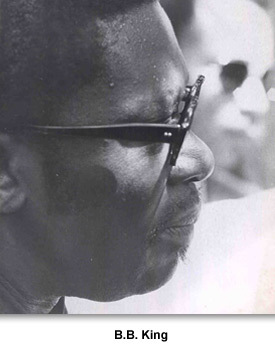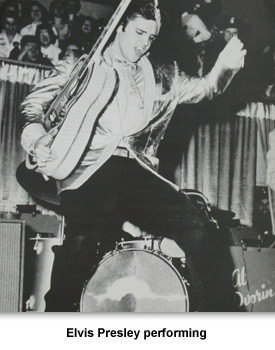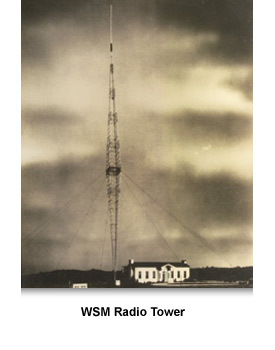Civil Rights / Cold War
Radio & Television
Radios became popular during the 1920s. Families with radios could now hear radio shows and music broadcast from great distances.
This popularity continued after World War II. By the mid-1950s, the transistor radio, a cheap portable variety, had appeared. Its small size allowed young people to listen to music of their choice without being monitored by parents.
Because society was segregated during the 1950s, the transistor radio helped break down racial barriers as white and black kids listened to music of both races.
WDIA AM in Memphis, the first all-black format station in the nation, was a pioneer in that area. One of their disc jockeys, Nat D. Williams, was the first African American in the South to regularly host a radio show. He hosted a morning show, then went to his teaching job at Booker T. Washington High School, and came back after school to host another show.
WDIA AM in Memphis, the first all-black format station in the nation, was a pioneer in that area. One of their disc jockeys, Nat D. Williams, was the first African American in the South to regularly host a radio show. He hosted a morning show, then went to his teaching job at Booker T. Washington High School, and came back after school to host another show.
Some of the white teens (and most of the black teens) also listened to so-called “race music” (rhythm and blues), performed by B.B. King, Ray Charles, and Arthur (Big Boy) Crudup.
In Nashville, WLAC radio switched from regular programming during the day to rhythm and blues at night. Disc jockeys like Bill "Hoss" Allen added “hip” talk to the music they played. Read more about the disc jockeys at WLAC.
As rock and roll developed, both black and white teenagers started listening to the same artists. The top song on the pop charts in 1951 was Patti Page’s version of the “Tennessee Waltz," a song that appealed to adults.
As rock and roll developed, both black and white teenagers started listening to the same artists. The top song on the pop charts in 1951 was Patti Page’s version of the “Tennessee Waltz," a song that appealed to adults.
By 1955, what is considered the first "hit" rock and roll song, “Rock Around the Clock” by Bill Haley and the Comets, was at the top of the charts. The next year, two tunes by Elvis Presley, “Love Me Tender” and “Heartbreak Hotel,” were one and two on the charts. Teenagers now accounted for 80 percent of record sales.
Television
Although radio had a tremendous impact on music tastes, television eventually surpassed it as the prime media. Since television produced both sound and image, young people could listen and watch their favorite performers.
Television networks started producing more shows for teenagers. During the week, the program American Bandstand was on television in the afternoons, after school. Teenagers could watch other teenagers dance to recorded music, and also watch performances.
Television was an essential element in helping many Tennesseans reach stardom. Elvis Presley was already a star when he appeared on the Ed Sullivan Show in 1957, but many who had never heard him began buying his records.
Two other Tennesseans who became famous as performers were Dinah Shore and
Pat Boone. Francis Rose “Dinah” Shore was born in Winchester, and moved to Nashville during her childhood, where she attended Hume Fogg High School and Vanderbilt University.
Pat Boone. Francis Rose “Dinah” Shore was born in Winchester, and moved to Nashville during her childhood, where she attended Hume Fogg High School and Vanderbilt University.
Shore landed a position as star performer on WSM radio in Nashville. She later moved to New York, the nation’s pop music center before the 1950s. Shore performed live for U.S. troops during World War II, and began hosting television shows in the 1950s.
She became a superstar in 1956, when she hosted a popular television series sponsored by Chevrolet. Her catchy Chevrolet jingle “See the USA in Your Chevrolet” helped boost the carmaker’s sales.
She became a superstar in 1956, when she hosted a popular television series sponsored by Chevrolet. Her catchy Chevrolet jingle “See the USA in Your Chevrolet” helped boost the carmaker’s sales.
Watch Shore perform the Chevrolet song from her television show.
Pat Boone was one of the most important pop singers of the 1950s, second only to Elvis Presley. During the 1950s, he repeatedly won several nationally popular TV amateur contests. After signing with Dot Records, he turned out a string of 26 hit songs including the song that propelled him to superstardom - a cover of Fats Domino’s “Ain’t That A Shame.”
Unlike Elvis, Boone had a clean-cut image, attracting teens and adults alike. As a result, his music was considered a safe alternative to parents who worried about their children listening to rebellious-sounding musical styles.
In the late 1960s, shows like Hee Haw and the Porter Waggoner Show, both produced in Nashville, helped market new country stars like Dolly Parton. TV had become a central force in bringing Tennesseans’ performances into the homes of millions of Americans.
Picture Credits:
- Photograph of the WSM Radio Tower. The Nashville radio tower was built in 1925 and transmitted at a range that covered several states before federal regulation of radio waves. The station’s broadcast of the Grand Ole Opry was a key factor in the development of the Nashville country music industry. Tennessee State Museum Collection, 95.19.63
- Photograph of B.B. King taken in 1971. B. B. King began his long career as a blues artist featured on Memphis’ WDIA – the nation’s first all-black format radio station. Courtesy of the University of Memphis Special Collections
- Photograph of an Elvis Presley Performing. Tennessee State Museum Collection, 2000.288.5.2
- Pop-up photograph of Dinah Shore. Shore, a singer and performer from Tennessee, got her start on WSM Radio in Nashville. She went on to become a popular television host. Tennessee State Museum Collection, 91.43.2.53
- Autographed photograph of Pat Boone. Boone was second in popularity only to Elvis during the 1950s. His clean-cut image provided an alternative to his rival from Memphis. Tennessee State Museum Collection, 91.43.2.145
Civil Rights / Cold War >> Everyday Life >> Music >> Radio & Television



 Sponsored by: National Endowment for the Humanities
Sponsored by: National Endowment for the Humanities